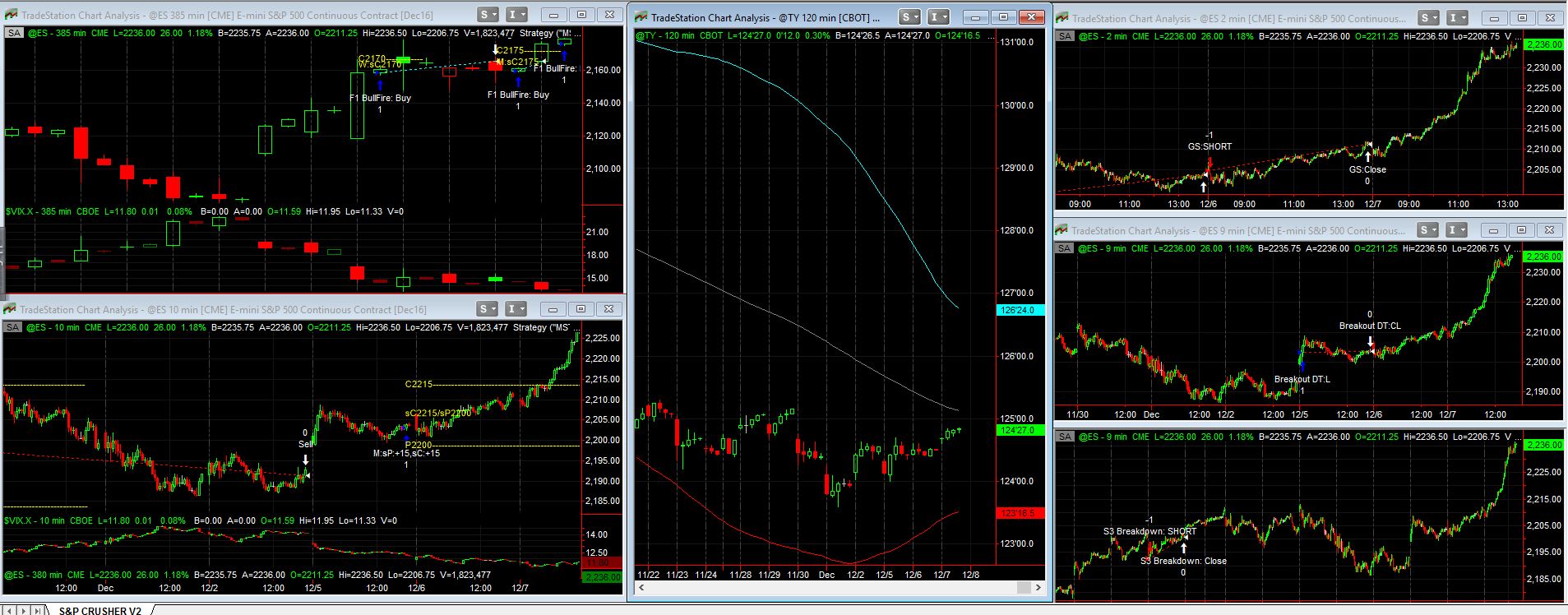ALGORITHMIC TRADING SYSTEM DESIGN & IMPLEMENTATION
Watch This Video Showing the Trader+ Return 19.50% In One Day.
Past performance is not indicative of future performance. Trading futures involve a substantial risk of loss and is not appropriate for all investors.
AlgorithmicTrading.net is a third-party trading system developer specializing in automated trading systems, algorithmic trading strategies, trading algorithm design, and quantitative trading analysis. We offer fully automated black-box trading systems that allows investors & traders to take advantage of market inefficiencies by placing high-probability trades while minimizing risk.
FEATURED ALGORITHMIC TRADING SYSTEM
Our Algorithmic Trading Strategies trade the S&P Emini (ES) Futures. They are 100% automated trading systems that can be auto executed by multiple NFA Registered Brokers under a Letter of Direction. Our featured trading system does not hold overnight, which means it has a smaller unit size ($15,000). Furthermore, the results in live trading have been spectacular making it our featured trading system as of June 2024.
ALPHA TRADER
- 9.83% Avg Per Month (WALK-FORWARD)
- Automated Trading System
- $50,000 Unit Size
- Trade With As Little As $30,000
- 81% Profitable Months
- S&P E-Mini Long & Short

Past performance is not indicative of future performance.
WATCH OUR TRADING SYSTEMS AS THEY TRADE LIVE
Each of our trading systems trades multiple uncorrelated strategies. In this video, you will see a few of them in action. These trades were seen on the Professional Package along with the Elite Trader. Pretty incredible results in just one day.

Trading futures involves substantial risk of loss and is not appropriate for all investors. Past performance is not indicative of future performance.
Multiple Types of Trading Strategies Are Used in Our Automated Trading Software
Each trading system (Trader+, Smart Pivot, Elite & Professional Package) utilizes a different set of trading algorithms. These different strategies can take long/short day trades or swing trades that can last 1-2 days. Each of the individual trading strategies is listed below, along with a brief description of it and what Trading Systems (Trader+, Smart Pivot, Elite & Professional Package) use it.
Day Trade V1 & V2
The Breakout Day Trading Strategy places day trades on the Emini-S&P Futures when the market shows strength in the morning. It utilizes a very tight stop while also trying to maximize the gains seen on winning trades.
The V2 adds a trailing stop and target.
Here’s a video recording of the Day Trade v1 that triggered on 13 May 2022. This trade resulted in a gain of approximately 15.3%. Just remember, past performance is not indicative of future performance.

This trading algorithm is used in all of the trading systems we currently offer: Trader+, Elite Trader, Smart Pivot & Professional Package.
Emerald Day Trading Algorithm
The Emerald Day Trading Strategy places both Long and Short day trades on the Emini-S&P Futures at various times throughout the day. It utilizes a larger “crash” stop and can hold the entire day or exit early based on the predictive exit logic. This trading system keys off of two different market states: Strong Up & Strong Down.
This trading algorithm is used in all of the trading systems we currently offer: Trader+ (Long/Short), Elite Trader (Long/Short), Smart Pivot (Long) & Professional Package (Long/Short).
Geronimo ES Trading Algorithm
The Geronimo ES Trading Strategy places long trades on the Emini-S&P Futures as equity markets are closing. It utilizes a larger “crash” stop during the overnight session and will either continue holding overnight (creating a swing trade) or exit the same day if a certain profit target is hit. The difference between the Geronimo ES and Bull-Fire ES is that the Geronimo ES uses a smaller target, meaning there is less risk it will hold overnight and will have a higher win rate.
This trading algorithm is used in all of the trading systems we currently offer: Elite Trader, Smart Pivot & Professional Package.
Watch this video to see it trading live as part of the Elite Trader.

While each of these trading strategies can be traded stand-alone, they are best traded in a broader collection of trading algorithms – as seen in one of our Automated Trading Systems such as Trader Plus or Elite Trader.
Are Machines Really Taking Over The Markets?
It depends on who you ask, but recent articles and investment letters put out by top rated brokers such as Goldman Sachs seem to suggest that machines and trading algorithms are in fact taking over. Large Hedge Funds such as Blackrock have recently begun investing heavily in Stock Picking Strategies which are driven by Algos. Have you considered deploying an Algorithmic Trading System to take advantage of this new trend? You don’t have to invest in a Hedge Fund, Family Office or Commodity Trading Pool to take advantage of this change in investment styles. You can actually deploy an Algorithmic Trading Solution through an NFA Registered Broker, utilizing one of our Trading Algorithms.
%
Percentage of Trades Placed by Automated Trading Systems
According to MacGregor, as of 2014 more than 75 percent of the stock shares traded on United States exchanges (including the New York Stock Exchange and NASDAQ) originate from automated trading system orders.
%
Percentage of Trading Considered to be Traditional Stock Picking
The Basics of Algorithmic Trading
Algorithmic Trading, also known as Quant Trading is a trading style which utilizes market prediction algorithms in order to find potential trades. There are various sub categories of quantitative trading to include High Frequency Trading (HFT), Statistical Arbitrage and Market Prediction Analysis. At AlgorithmicTrading.net, we focus on developing automated trading systems that place swing, day and options trades in order to take advantage of various market inefficiencies.

Algorithmic Trading Example
Ready To Join The Automated/Algorithmic Trading Revolution?
Covering the Essentials of Automated Trading System Design
VERY HIGH AVERAGE GAIN PER MONTH
Our black-box trading systems are fully automated, designed to help remove the emotions from trading. In live trades, clients using the Trader+ Trading System were able to generate returns of 6.81% per month on average. Just remember, past performance is not indicative of future performance. This is not for everyone.
MULTIPLE TRADING ALGORITHMS WORKING TOGETHER
Our quant trading methodology has us employing multiple algo trading strategies in order to better diversify your auto trading account. Learn more by visiting our trading strategies design methodology page. As an example, Elite Trader is trading 5 strategies at once, while Smart Pivot & Trader+ is trading 3. The Professional Package combines the two and trades a total of 8 strategies.
TRADES DURING BULL & BEAR MARKETS
In our opinion, the key to developing an algorithmic trading system that actually works is to account for multiple market conditions. At any time, the market could transition from a bull to a bear market. By taking a market direction agnostic position we are attempting to outperform in both Bull & Bear market conditions. This is accomplished by taking both Long and Short positions on the S&P Eminis.
FULLY AUTOMATED TRADING SYSTEM
You can auto trade our algorithmic trading systems using an auto-execution broker (with best-efforts). We have multiple brokers for you to choose from. Remove emotional based decisions from your trading by using our automated trading system.
FOLLOW ALONG IN REAL TIME
Track the daily progress of our quantitative trading algorithms with the OEC broker app. You will also receive daily statements from the NFA Registered clearing firm.
EMPHASIS ON RISK MANAGEMENT
Our Automated Trading Systems will place directional Long & Short day trades along with the occasional swing trade (Pro, Elite, Smart Pivot). It should be noted, the Trader+ does not hold positions overnight. Overnight risk is minimized since the majority of trades are day-trades which run with stops and exit their positions before or just after the equity markets close at 4:00 PM EST.
DISCLAIMER
U.S. Government Required Disclaimer – Commodity Futures, Trading Commission Futures, Derivatives and Options trading has large potential rewards, but also large potential risk. You must be aware of the risks and be willing to accept them in order to invest in the futures and options markets. Don’t trade with money you can’t afford to lose. This website is neither a solicitation nor an offer to Buy/Sell futures, options, or any other assets. The past performance of any trading system or methodology is not necessarily indicative of future results.
*CFTC RULE 4.41: Results are based on simulated or hypothetical performance results that have certain inherent limitations. Unlike the results shown in an actual performance record, these results do not represent actual trading. Also, because these trades have not actually been executed, these results may have under-or over-compensated for the impact, if any, of certain market factors, such as lack of liquidity. Simulated or hypothetical trading programs in general are also subject to the fact that they are designed with the benefit of hindsight. No representation is being made that any account will or is likely to achieve profits or losses similar to these being shown.
Do You Have Any Examples Of These Systems Trading Live?
Yes, in this playlist, you will see multiple videos highlighting different strategies traded within any given Trading System, such as the Professional Package.


What Is The Difference Between The Different Trading Systems You Offer?
This playlist provides you with a brief overview of the different futures based trading systems we offer (Professional:$50K, Elite:$35K, Smart Pivot:$25K & Trader+:$15K).

What Separates Algorithmic Trading From Other Technical Trading Techniques?
These days, it seems like everyone has an opinion on Technical Trading techniques. Head & Shoulders patterns, MACD Bullish Crosses, VWAP Divergences, the list goes on and on. In these video blogs, our lead design engineer analyzes a few examples of trading strategies found online. He takes their Trading Tips, codes it up and runs a simple back-test to see how effective they really are. After analyzing their initial results, he optimizes the code to see if a quantitative approach to trading can improve the initial findings. If you are new to algorithmic trading, these video blogs will be quite interesting. Our designer utilizes finite state machines to code up these basic trading tips. How does Algorithmic Trading differ from traditional technical trading? Simply put, Algorithmic Trading requires precision and gives a window into an algorithms potential based on back-testing which does have limitations.
Looking For Free Algorithmic Trading Tutorial & How To Videos?
Watch multiple educational video presentations by our lead designer on algorithmic trading to include a video covering our Quant Trading Design Methodology and an Algorithmic Trading Tutorial. These trading strategy videos provide algorithmic trading coding examples and introduce you to our approach of trading the markets using quantitative analysis. In these videos you will see many reasons why automated trading is taking off to include helping to remove your emotions from trading. Visit our Educational Trading Videos page to see a full list of educational media.
Start Using One Of Our Automated Trading Systems Today
Don’t miss out. Join those already trading with AlgorithmicTrading.net. Get started today with one of our algorithmic trading packages.
Multiple Automated Trade Execution Options Are Available
Our trading algorithms can be auto-executed with best-efforts under a Letter of Direction (LOD) using one of the following NFA registered auto-execution brokers.

Capital Trading Group is an NFA registered broker who can auto-execute our algorithms with best efforts. They are part of our newest addition of supported brokers and are able to support customers worldwide (including Canadian).
Questions?
Make sure you visit our Frequently Asked Questions page to see a list of common questions and answers. You can also click here to learn more about AlgorithmicTrading.net and it’s Lead Developer.

 Subscribe to my channel
Subscribe to my channel
